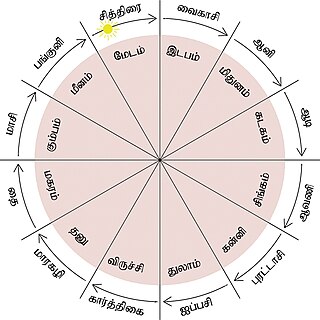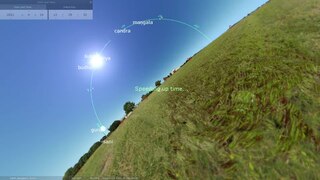
Chandra, also known as Soma, is the Hindu god of the Moon, and is associated with the night, plants and vegetation. He is one of the Navagraha and Dikpala.
Hindu astrology, also called Indian astrology, Jyotisha and, more recently, Vedic astrology, is the traditional Hindu system of astrology. It is one of the six auxiliary disciplines in Hinduism that is connected with the study of the Vedas.
The Hindu calendar, also called Panchanga, is one of various lunisolar calendars that are traditionally used in the Indian subcontinent and Southeast Asia, with further regional variations for social and Hindu religious purposes. They adopt a similar underlying concept for timekeeping based on sidereal year for solar cycle and adjustment of lunar cycles in every three years, but differ in their relative emphasis to moon cycle or the sun cycle and the names of months and when they consider the New Year to start. Of the various regional calendars, the most studied and known Hindu calendars are the Shalivahana Shaka found in the Deccan region of Southern India and the Vikram Samvat (Bikrami) found in Nepal and the North and Central regions of India – both of which emphasize the lunar cycle. Their new year starts in spring. In regions such as Tamil Nadu and Kerala, the solar cycle is emphasized and this is called the Tamil calendar and Malayalam calendar and these have origins in the second half of the 1st millennium CE. A Hindu calendar is sometimes referred to as Panchangam (पञ्चाङ्गम्), which is also known as Panjika in Eastern India.

In Vedic timekeeping, a tithi is a "duration of two faces of moon that is observed from earth", known as milа̄lyа̄ in Nepal Bhasa, or the time it takes for the longitudinal angle between the Moon and the Sun to increase by 12°. In other words, a tithi is a time duration between the consecutive epochs that correspond to when the longitudinal angle between the Sun and the Moon is an integer multiple of 12°. Tithis begin at varying times of day and vary in duration approximately from 19 to 26 hours. Every day of a lunar month is called tithi.
Nakshatra is the term for Lunar mansion in Hindu astrology and Buddhist astrology. A nakshatra is one of 27 sectors along the ecliptic. Their names are related to a prominent star or asterisms in or near the respective sectors. In essence, a nakshatra simply is a constellation. Every nakshatra is divided into four padas related to the Char Dham, a set of four pilgrimage sites in India.

The Tamil calendar is a sidereal solar calendar used by the Tamil people of the Indian subcontinent. It is also used in Puducherry, and by the Tamil population in Sri Lanka, Malaysia, Singapore, Myanmar and Mauritius.

In Thailand, two main calendar systems are used alongside each other: the Thai solar calendar, based on the Gregorian calendar and used for official and most day-to-day purposes, and the Thai lunar calendar, used for traditional events and Buddhist religious practices.
Often called lunar mansion, a lunar station or lunar house is a segment of the ecliptic through which the Moon passes in its orbit around the Earth. The concept was used by several ancient cultures as part of their calendrical system.
Paksha (Sanskrit: पक्ष, romanized: pakṣa) refers to a fortnight or a lunar phase in a month of the Hindu lunar calendar.
Dasha The dasha pattern shows which planets according to Hindu astrology would be ruling at particular times.
The term Varga in Indian astrology (Jyotisha) refers to the division of a zodiacal sign (rāśi) into parts. Each such fractional part of a sign, known as an aṃśa, has a source of influence associated with it, so that these sources of influence come to be associated with collections of regions around the zodiac.
In Vedic Astrology Jyotiṣa, the Lagna or Hour Marker, is the first moment of contact between the soul and its new life on earth in Jyotiṣa. Lagna's Rashi and Nakshatra represents the "Atman" (Soul) of an Individual Person while the Lagna Lord represents the Ruler of the Horoscope and therefore the Rashi & Nakshatra where the Lagna Lord is positioned is equally very important as the Lagna Lord also absorbs the traits and qualities of that specific Rashi & Nakshatra.
In Hindu astrology, yoga is the relationship between one planet, sign, or house to another by placement, aspect, or conjunction. It is the consideration of the planetary dasha's directional effects, the most important factor which distinguishes Hindu astrology from Western astrology.
Trikonasthanas or trikonas or trines are conventionally the Lagna or the Birth-ascendant, the fifth and the ninth bhava or house counted from the Lagna. They form the Dharma-trikona and are also known as the Lakshmisthanas, these bhavas and their lords signify luck and prosperity. The Lagna is both, a kendrasthana and a trikonasthana.
Sarvatobhadra Chakra in Hindu astrology is a unique technique for prediction based on the Nakshatras. It is an ancient system because it takes into account Abhijit nakshatra which is now not referred to in matters pertaining to methods that are generally employed for making astrological predictions. Janardan Harji in his Mansagari has described it as - संप्रवक्ष्यामि चक्रं त्रिलोक्यदीपिकम् - the trust-worthy quickly-revealing Trilokyadeepika Chakra.The term, Sarvatobhadra, derived from Sarva (सर्व) meaning – all, and Bhadra (भद्र)) meaning – good or auspicious, means overall auspiciousness. Abhijit nakshatra is located between Uttarashada and Sravana, it is the last quarter of Uttarashada and the first half of Sravana nakshatra.
Siṃha is one of the twelve months in the Indian solar calendar.

The Hindu calendar is based on a geocentric model of the Solar System. A geocentric model describes the Solar System as seen by an observer on the surface of the Earth.
In Indian astronomy, yoga (also called nityayoga) is a period of time, of varying lengths, during which the sum of the nirayana longitudes of the Sun and the Moon increases by an amount of 13 degrees 20 minutes (or, equivalently, 800 minutes). While considering the sum, when the sum is 360 degrees or more, then the angle 360 degrees is subtracted from the sum to make the sum an angle between 0 degree and 360 minutes. Consider a moment T1 when the sum of the longitudes of the Sun and the Moon is 0 degree and let T2 be the next immediate moment when the sum of the longitudes of the Sun and the Moon is 13 degree 20 minutes. The duration of time between the moments T1 and T2 is the first yoga. Similarly, let the next immediate moment when the sum of the longitudes of the Sun and Moon is 26 degrees 40 minutes. The duration of time between the moments T2 and T3 is the second yoga. The third, fourth and higher yoga-s are defined in a similar way. Since 27 X 13 degrees 20 minutes = 360 degrees, at the end-moment of the 27th yoga, the sum of the nirayana longitudes of the Sun and Moon would be 0 degree. The numbering of the yoga-s then starts afresh from that point. It appears that the astronomical yoga-s are in no way related to any astronomical phenomena. S. B. Dikshit in his Bhāratīya Jyotiṣ Śāstra observes: "It is not known what planetary position in the sky is indicated by yoga, and it is useful only in astrology."
In Indian astronomy, a karaṇa is a half of a tithi. It is the duration of time in which the difference of the longitudes of the Sun and the Moon is increased by 6 degrees. A lunar month has 30 tithi-s and so the number of karaṇa-s in a lunar month is 60. These sixty karaṇa-s are not individually named. Instead, the originators of the concept have chosen 11 names to be associated with the karaṇa-s which means several karaṇa-s will be associated with the same name. Of these 11 names, four are fixed or immovables in the sense that they are associated with four unique karaṇa-s in a lunar month. These constant names are Śakuni, Catuṣpāda, Nāga and Kimstughna. The remaining seven names are variable or movable in the sense that there are several karaṇa-s associated with each of them. These names are Bava, Bālava, Kaulava, Taitila, Gara, Vaṇij and Vṛṣṭi.
In Indian calendrical systems, vāra denotes the week-day. It is one of the five elements that constitute the traditional almanacs called Pañcāṅga-s the other four being Nakshatra, Tithi, Karaṇa and Nityayoga. The concept of week, the unit of time consisting of seven days, is indigenous to Indian civilisation. The concept was probably borrowed by Babylonians and its use predates the use of the twelve zodiacal signs in Indian civilazation. The concept finds mention in Atharva Veda. The seven week-days are named after the seven classical planets as in the ancient Greek and Roman traditions.







